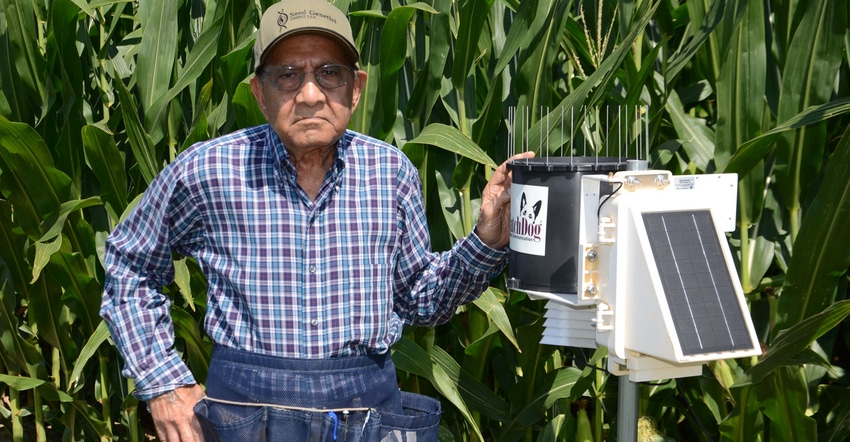
The critical grain fill period after pollination began with rainfall still scarce. A weather station that tracks soil moisture, rainfall, temperature and relative humidity was installed at the Corn Watch ’22 site on July 29.
When the station was set up, a moisture sensor was installed about six rows inside the field. A second sensor was installed at the edge of the field, next to the outside row. This weather station model reads one sensor at a time.
Related: Factor hot, dry weather into yield estimates
The sensor measures soil moisture as a percentage of water-holding capacity of the soil at a depth of 6 inches. When soils are wet, the soil moisture reading can rise over 40%. During extreme dry weather in August 2021 at the Soybean Watch ’21 field, soil moisture readings dipped to as low as 7% before rains returned.
The sensor inside the Corn Watch ’22 field read about 3.5% soil moisture. When the sensor on the outside edge was connected, it read about 6.5%.
“We really thought there was a problem with the sensors to read so low,” says Dave Nanda, director of genetics for Seed Genetics Direct, sponsor of Corn Watch ’22. However, when it began raining, soil moisture shot up as expected. Four inches of rain were recorded during the first 12 days in August at the site. By Aug. 12, soil moisture was 23.3%.
Better grain fill
There was no problem with the soil moisture sensors, Nanda concluded. It was just much drier than even he imagined until he saw the soil moisture sensor data.
“The good news is that corn was doing much better than you might expect even before these recent rains,” Nanda says. Based on estimates taken in two locations within the field in early August, yields over 200 bushels per acre are still possible in this field, despite the extreme heat and drought experienced through almost all of June and July.
“You have to give credit to plant breeders and modern genetics,” Nanda says. “The hot, dry weather impacted yield. Some ears are shorter than normal, not all tips are filled, and there are scattered missing kernels where pollination was likely affected by extreme heat.
“But the bottom line is that this will still be good corn to harvest. Even on the higher, eroded knobs — which looked so stressed in early July — there are reasonably sized ears on most plants.”
The factor still to be determined is size of kernels and kernel weight, Nanda says. While set somewhat by genetics, weather during the grain fill period, extending all the way to black layer, plays a big role in determining kernel weight.
“With rains and soil moisture returning to reasonable levels, it bodes well for grain fill here,” Nanda says. “Now it’s important to continue scouting and make sure a late disease outbreak doesn’t set in. There is still risk that a disease could impact grain fill if it developed quickly.”
About the Author(s)
You May Also Like




